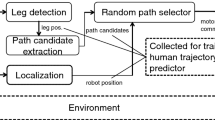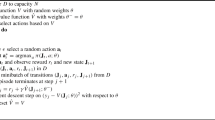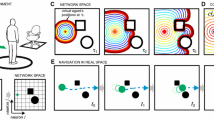Abstract
Crowd navigation with autonomous systems is a topic which has seen a rapid increase in interest recently. While it appears natural to humans, being able to reach a target can prove difficult or impossible to a mobile robot because of the safety issues related to collisions with people. In this work we propose an approach to control a robot in a crowded environment; the method employs an Artificial Neural Network (ANN) that is trained with the NeuroEvolution of Augmented Topologies (NEAT) method. Models for the kinematics, perception, and cognition of the robot are presented. In particular, perception is based on a raycasting model which is tailored on the ANN. An in-depth analysis of a number of parameters of the environment and the robot is performed and a comparative analysis is presented; finally, results of the performance of the controller trained with NEAT are compared to those of a human driver who takes over the controller itself. Results show that the intelligent controller is able to perform on par with the human, within the simulated environment.
Article PDF
Similar content being viewed by others
Explore related subjects
Discover the latest articles, news and stories from top researchers in related subjects.Avoid common mistakes on your manuscript.
Availability of data and material
The data that support the findings of this study are available from the corresponding author, S.S., upon reasonable request.
Code availability
The code used to generate the results presented in this study is available from the corresponding author, S.S., upon reasonable request.
References
Jeon, S., Lee, J.: Performance analysis of scheduling multiple robots for hospital logistics. pp. 937–940 (2017)
Bays, M., Wettergren, T.: Service agent–transport agent task planning incorporating robust scheduling techniques. Robot. Auton. Syst. 89, 15–26 (2017)
Hernandez, K., Bacca, B., Posso, B.: Multi-goal path planning autonomous system for picking up and delivery tasks in mobile robotics. IEEE Lat. Am. Trans. 15(2), 232–238 (2017)
Baker, M., Yanco, H.: Automated street crossing for assistive robots. 2005, 187–192 (2005)
Bauer, A., Klasing, K., Lidoris, G., Mühlbauer, Q., Rohrmüller, F., Sosnowski, S., Xu, T., Kühnlenz, K., Wollherr, D., Buss, M.: The autonomous city explorer: Towards natural human-robot interaction in urban environments. Int. J. Soc. Robot. 1(2), 127–140 (2009)
Chung, M.Y., Pronobis, A., Cakmak, M., Fox, D., Rao, R.: Autonomous question answering with mobile robots in human-populated environments. vol. 2016-November, pp. 823–830 (2016)
Radwan, N., Winterhalter, W., Dornhege, C., Burgard, W.: Why did the robot cross the road? - learning from multi-modal sensor data for autonomous road crossing. vol. 2017-September, 4737–4742 (2017)
Lutin, J., Kornhauser, A., Lerner-Lam, E.: The revolutionary development of self-driving vehicles and implications for the transportation engineering profession. ITE J (Inst Transport Eng) 83(7), 28–32 (2013)
Lombardi, G., Medvet, E., Bartoli, A.: A language for Uav traffic rules in an urban environment and decentralized scenario. In: 2017 IEEE 29th International Conference on Tools with Artificial Intelligence (ICTAI), pp. 1139–1143. IEEE (2017)
Burgoon, J.K., Jones, S.B.: Toward a theory of personal space expectations and their violations. Hum. Commun. Res. 2(2), 131–146 (1976)
Guzzi, J., Giusti, A., Gambardella, L.M., Theraulaz, G., Caro, G.A.D.: Human-friendly robot navigation in dynamic environments. In: 2013 IEEE international conference on robotics and automation, pp. 423–430 (2013)
Hebesberger, D., Koertner, T., Gisinger, C., Pripfl, J.: A long-term autonomous robot at a care hospital: A mixed methods study on social acceptance and experiences of staff and older adults. Int. J. Soc. Robot. 9, 417–429 (2017)
Trautman, P., Krause, A.: Unfreezing the robot navigation in dense, interacting crowds. In: 2010 IEEE/RSJ International Conference on Intelligent Robots and Systems, pp. 797–803 (2010)
Luber, M., Spinello, L., Silva, J., Arras, K.O.: Socially-aware robot navigation: A learning approach. In: 2012 IEEE/RSJ International Conference on Intelligent Robots and Systems, pp. 902–907 (2012)
Trautman, P.: Robot Navigation in Dense Crowds Statistical Models and Experimental Studies of Human Robot Cooperation. Doctoral Thesis, California Institute of Technology,Pasadena, California (2013)
Trautman, P., Ma, J., Murray, R.M., Krause, A.: Robot navigation in dense human crowds: The case for cooperation. In: 2013 IEEE International Conference on Robotics and Automation, pp. 2153–2160 (2013)
Trautman, P., Ma, J., Murray, R.M., Krause, A.: Robot navigation in dense human crowds: Statistical models and experimental studies of human–robot cooperation. Int. J. Robot. Res. 34(3), 335–356 (2015). https://doi.org/10.1177/0278364914557874
May, A.D., Dondrup, C., Hanheide, M.: Show Me Your Moves! Conveying navigation intention of a mobile robot to humans. In: 2015 European Conference on Mobile Robots (ECMR), pp. 1–6 (Sept 2015)
Shrestha, M.C., Kobayashi, A., Onishi, T., Yanagawa, H., Yokoyama, Y., Uno, E., Schmitz, A., Kamezaki, M., Sugano, S.: Exploring the use of light and display indicators for communicating directional intent. In: 2016 IEEE International Conference on Advanced Intelligent Mechatronics (AIM), pp. 1651–1656 (2016)
Shrestha, M.C., Kobayashi, A., Onishi, T., Uno, E., Yanagawa, H., Yokoyama, Y., Kamezaki, M., Schmitz, A., Sugano, S.: Intent communication in navigation through the use of light and screen indicators. In: 2016 11th ACM/IEEE International Conference on Human-Robot Interaction (HRI), pp. 523–524 (2016)
Chik, S., Yeong, C., Su, E., Lim, T., Subramaniam, Y., Chin, P.: A review of social-aware navigation frameworks for service robot in dynamic human environments. J. Telecommun. Electron. Comput. Eng. 8(11), 41–50 (2016)
Narayanan, V.K., Spalanzani, A., Luo, R.C., Babel, M.: Analysis of an adaptive strategy for equitably approaching and joining human interactions. In: 2016 25th IEEE International Symposium on Robot and Human Interactive Communication (RO-MAN), pp. 341–346 (2016)
Park, C., Ondřej, J., Gilbert, M., Freeman, K., O’Sullivan, C.: Hi Robot: Human intention-aware robot planning for safe and efficient navigation in crowds. In: 2016 IEEE/RSJ International Conference on Intelligent Robots and Systems (IROS), pp. 3320–3326 (2016)
Chatterjee, I., Steinfeld, A.: Performance of a low-cost, human-inspired perception approach for dense moving crowd navigation. In: 2016 25th IEEE International Symposium on Robot and Human Interactive Communication (RO-MAN), pp. 578–585 (2016)
Bohorquez, N., Sherikov, A., Dimitrov, D., Wieber, P.B.: Safe navigation strategies for a biped robot walking in a crowd. In: 2016 IEEE-RAS 16th International Conference on Humanoid Robots (Humanoids), pp. 379–386 (2016)
Kim, B., Pineau, J.: Socially adaptive path planning in human environments using inverse reinforcement learning. Int. J. Soc. Robot. 8, 51–66 (2016)
Vemula, A., Mülling, K., Oh, J.: Modeling cooperative navigation in dense human crowds. arXiv:1705.06201 (2017)
Bera, A., Randhavane, T., Prinja, R., Manocha, D.: Sociosense: Robot navigation amongst pedestrians with social and psychological constraints. arXiv:1706.01102 (2017)
Patle, B., Parhi, D., Jagadeesh, A., Kashyap, S.: Application of probability to enhance the performance of fuzzy based mobile robot navigation. Appl Soft Comput J 75, 265–283 (2019)
Al-Araji, A., Ibraheem, B.: A comparative study of various intelligent optimization algorithms based on path planning and neural controller for mobile robot. Univ. Baghdad Eng. J. 25(07), 80–99 (2019)
Das, S., Mohanty, S., Behera, A., Parhi, D., Pradhan, S.: Navigational control analysis of mobile robot in cluttered unknown environment using novel neural-gsa technique. Lecture Notes Mechan. Eng. 551–563 (2020)
Chen, Y., Liu, C., Shi, B., Liu, M.: Robot navigation in crowds by graph convolutional networks with attention learned from human gaze. IEEE Robotics Autom. Lett. 5(2), 2754–2761 (2020)
Rizk, Y., Awad, M., Tunstel, E.: Decision making in multiagent systems: A survey. IEEE Trans. Cognitive Develop. Syst. 10(3), 514–529 (2018)
Abbas, H., Saha, I., Shoukry, Y., Ehlers, R., Fainekos, G., Gupta, R., Majumdar, R., Ulus, D.: Special session: Embedded software for robotics: Challenges and future directions (2018)
Chen, Y., Gan, W., Zhang, L., Liu, C., Wang, X.: A survey on visual place recognition for mobile robots localization. vol. 2018-January, pp. 187–192 (2018)
Dudarenko, D., Kovalev, A., Tolstoy, I., Vatamaniuk, I.: Robot navigation system in stochastic environment based on reinforcement learning on lidar data. Smart Innov. Syst. Technol. 154, 537–547 (2020)
Gordon, V.S., Whitley, L.D.: Serial and parallel genetic algorithms as function optimizers. In: Proceedings of the 5th International Conference on Genetic Algorithms, pp. 177–183. Morgan Kaufmann Publishers Inc, San Francisco (1993)
Gomez, F., Miikkulainen, R.: Solving non-markovian control tasks with neuroevolution. 2, 1356–1361 (1999)
Moriarty, D., Miikkulainen, R.: Forming neural networks through efficient and adaptive coevolution. Evol. Comput. 5(4), 373–399 (1997)
Kaelbling, L., Littman, M., Moore, A.: Reinforcement learning: A survey. J. Artif. Intell. Res. 4, 237–285 (1996)
Stanley, K., Miikkulainen, R.: Evolving neural networks through augmenting topologies. Evol. Comput. 10(2), 99–127 (2002)
Buk, Z., Koutník, J., Šnorek, M.: Neat in hyperneat substituted with genetic programming. In: Lecture Notes in Computer Science (including subseries Lecture Notes in Artificial Intelligence and Lecture Notes in Bioinformatics) 5495 LNCS, pp. 243–252 (2009)
Caceres, C., Rosario, J., Amaya, D.: Approach of kinematic control for a nonholonomic wheeled robot using artificial neural networks and genetic algorithms (2017)
Srivastava, N., Hinton, G., Krizhevsky, A., Sutskever, I., Salakhutdinov, R.: Dropout: A simple way to prevent neural networks from overfitting. J. Mach. Learn. Res. 15, 1929–1958 (2014)
Ying, X.: An overview of overfitting and its solutions. vol. 1168 (2019)
Antonio, F.: Iv.6 - Faster line segment intersection. In: Kirk, D (ed.) Graphics Gems III (IBM Version), pp. 199–202. Morgan Kaufmann, San Francisco (1992)
Funding
Open Access funding provided by Università degli Studi di Trieste. This work has been partially supported by the PRIN project779 SEDUCE n. 2017TWRCNB and by the University of Trieste - University funding for scientific research projects - FRA 2018.
Author information
Authors and Affiliations
Contributions
Conceptualization: L.M., S.S., E.M., P.G.; Methodology: L.M., S.S., E.M.; Software: L.M., S.S; Validation: S.S., M.C.; Formal analysis: S.S.; Investigation: S.S., L.M.; Resources: S.S.; Data Curation: S.S.; Writing - Original Draft: S.S., E.M., L.M., M.C.; Writing - Review & Editing: S.S., P.G., E.M.; Visualization: S.S., M.C.; Supervision: S.S., P.G.; Project administration: S.S., P.G., E.M.; Funding acquisition: S.S., P.G.
Corresponding author
Ethics declarations
Conflict of Interests
The authors declare that they have no conflict of interest.
Additional information
Publisher’s Note
Springer Nature remains neutral with regard to jurisdictional claims in published maps and institutional affiliations.
Rights and permissions
Open Access This article is licensed under a Creative Commons Attribution 4.0 International License, which permits use, sharing, adaptation, distribution and reproduction in any medium or format, as long as you give appropriate credit to the original author(s) and the source, provide a link to the Creative Commons licence, and indicate if changes were made. The images or other third party material in this article are included in the article's Creative Commons licence, unless indicated otherwise in a credit line to the material. If material is not included in the article's Creative Commons licence and your intended use is not permitted by statutory regulation or exceeds the permitted use, you will need to obtain permission directly from the copyright holder. To view a copy of this licence, visit http://creativecommons.org/licenses/by/4.0/.
About this article
Cite this article
Seriani, S., Marcini, L., Caruso, M. et al. Crowded Environment Navigation with NEAT: Impact of Perception Resolution on Controller Optimization. J Intell Robot Syst 101, 36 (2021). https://doi.org/10.1007/s10846-020-01308-8
Received:
Accepted:
Published:
DOI: https://doi.org/10.1007/s10846-020-01308-8




